Perhaps one of the brightest representatives of the cichlid family in aquariums is the parrot fish. This unusual creature is not only unique in appearance, but also quick-witted. In order for the fish to please its beauty as long as possible, it is important to follow all the rules of maintenance and care.
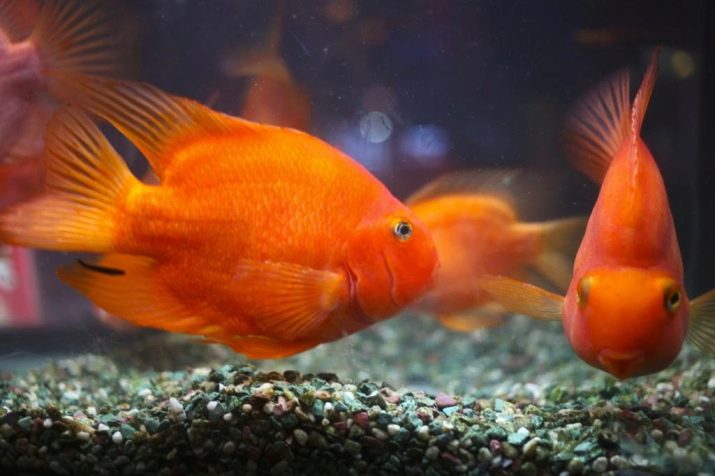
Description
For the first time having seen this interesting fish, many recall aquatic cartoon characters. This creature really has a “face” with a very cute expression resembling a cartoon character. This gullible muzzle very successfully harmonizes with the friendly and shy nature of the fish. The parrot fish borrowed a level of intelligence from cichlids, but did not inherit an aggressive disposition.
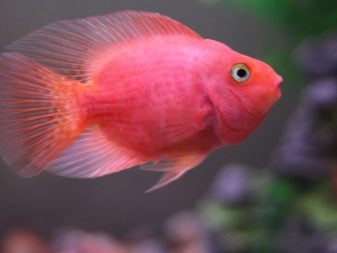
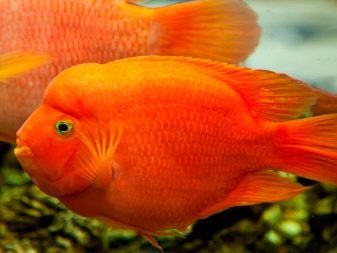
Mostly individuals of orange or red color are found. Gradually, the color fades, but when carotene is added to the aquarium, the scales again become colorful. Occasionally, breeders can find albinos with a snow-white or yellowish body.
All other colors known in aquariums: violet, green, blue and others are the result of chemical coloring of fish. Such individuals have a weak immune system, and therefore their lifespan is markedly reduced. In addition, artificial coloring is washed off over time.
Spotted varieties are also found, the most famous colors are panda, marble, motley pearl and diamond.
Pearl and diamond species are obtained by breeding red parrots and other varieties of cichlase.When black spots are visible on the skin, it can be assumed that the pet is under stress, so you need to find out the cause of the disease and solve the problem.
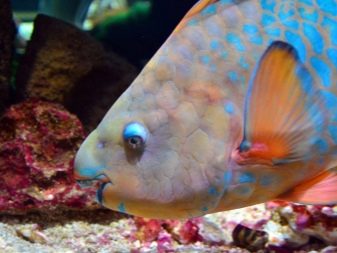
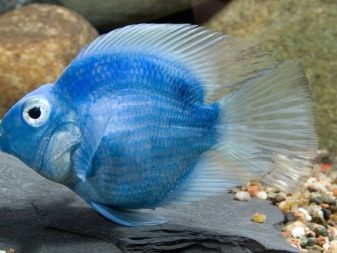
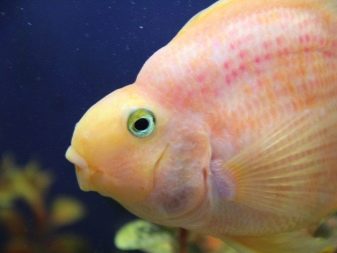
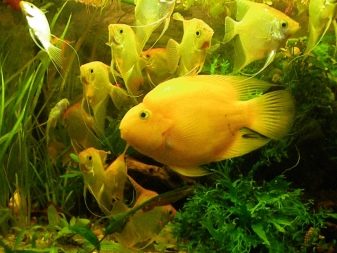
Care and maintenance
For two individuals, an aquarium of 50-70 liters is needed. Parrot fish are modest creatures who prefer not to attract attention, so it is important to plant some plants and equip the tank with a grotto, snags and other decorations that the fish will use as shelters. In vegetation, cichlids have no preferences, but more often experts use anubias, cryptocorynes, echinodorus. It is recommended to seat them at the edges and along the back wall, and leave the center for free swimming of aquarium inhabitants.
Parrots are also unpretentious to decorations, they will be glad even to a ceramic pot, but most of all they will be attracted by the shell of a boiled coconut. As a soil, aquarists advise buying pebbles without sharp edges, so that the corners do not injure the fish. The recommended soil layer is 5 cm. Do not use high power devices for lighting.
Suitable dim red lamps. So, 0.3-0.5 watts per liter of net volume of aquarium water will be enough. If the light is brighter, then the color of the fish will gradually fade.
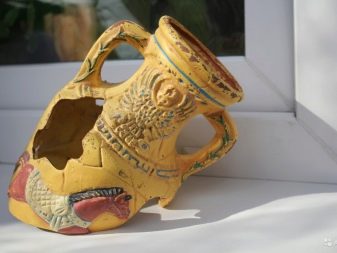
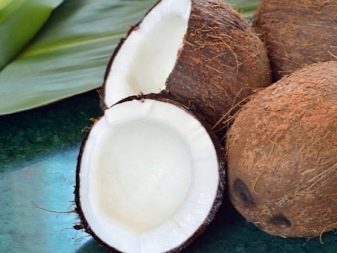
Parrots quickly get used to their territory. Having chosen the most suitable site, for example, a coconut with a hole, the fish will no longer exchange its house for another shelter. A pet can even begin to equip itself with a home, for example, carry there important, in his opinion, materials found in the aquarium. When keeping the fish, it is worth considering their “homebodies” and try to prepare in advance a convenient place for housing with a hole.
For a comfortable life, these fish need water with a hardness of not more than 10 dGH and an acidity of 6.5-7.0 pH. Put a heater in the aquarium and maintain the temperature at 24-26 degrees. Equip the aquarium with an external or internal filter, and do not forget to regularly clean the unit. Particularly frequent cleaning requires an internal filter. Also stock up on aeration systems that will enrich the water in your tank with oxygen.
Due to the inability of cichlids to pick food from the bottom, their aquarium is contaminated quite quickly, so it is recommended to periodically clean the soil with a siphon, and also change 1/3 of the water weekly. When adding gravy, use water that has settled for 24 hours.
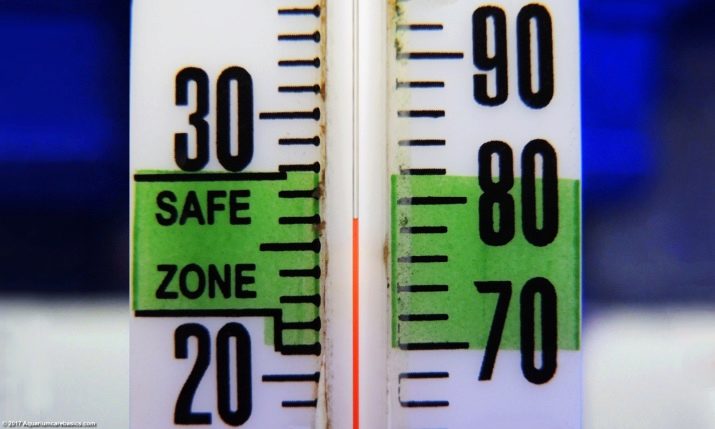
Feeding
Particular attention should be paid to feeding parrot fish. The fact is that they have a very unusual body structure, namely, the mouth opening at a small angle, and therefore food intake sometimes makes them difficult. These pets are only able to eat food that floats on the surface or begins to settle to the bottom, and it is impossible to pick up a piece of food for a fish with such a non-standard jaw from the bottom.
Concerning parrots are recommended to be dosed. Please note that shops are offered special granular feed which floats for a long time on the surface, and therefore the fish have time to feast on them until the granules sink to the bottom.
In addition to ready-made feeds, live or frozen dressings can be included in the diet. For example, you can offer shrimp or worm meat to aquarium pets. In order for the paled fish to become bright and colorful again, you can feed it with products with lots of carotene.
Feeding with plant foods, for example, zucchini, peas, bell pepper, is quite acceptable. Frequency of feeding — 1-2 times a day, also once a week it is recommended to arrange fasting days.
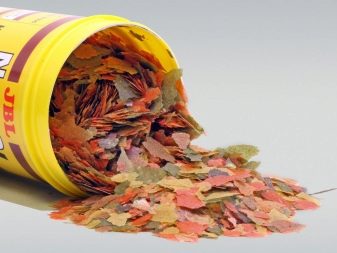
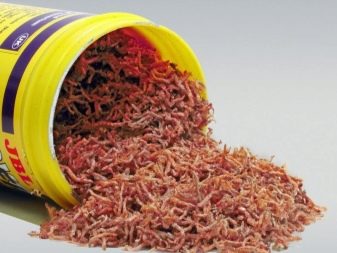
Compatible with other fish
Parrot fish is a peaceful and benevolent creature that gets along well with many types of fish. These creatures will not engage in battle for territory or show interest in the veil fins of their neighbors. Although among the parrots there are aggressive species.These include, for example, a green cone-like parrot. The manifestation of anger is possible on the part of males during the spawning period.
The most conflict-free union will result from the sharing of fish that love digging in the ground to parrots. Good neighbors can become black knives, catfish, haracin, South American cichlids, barbs, labeos, aravana, Congo, white-fronted apteronotus.
Not the most successful relationship will develop with parrots with scalars who like to spend time in the bushes. A parrot fish in the process of swallowing thickets can simply mix up its flat neighbor with a fragment of vegetation and take up its fins.
Such a neighborhood is only possible in an aquarium of at least 200 liters. It is also not recommended to settle next to cichlids of small fish less than 5 cm long, for example, neons, guppies, gracilis, because they can also become the object of food of voracious parrots.
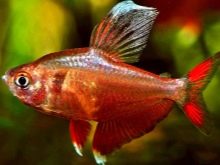
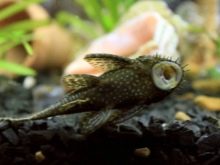
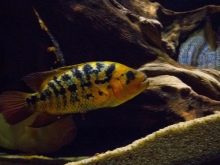
Breeding
Like all cichlids, parrot fish form in pairs already in their teens. Male and female individuals remain faithful to each other until the end. An existing pair of fish together equips a place for caviar, cleans the surface of the site, performs rituals of courtship. As is customary for cichlids, the male and female protect eggs from enemies, during this period the father becomes aggressive, which is generally unusual for parrot fish.
However, all the actions of the couple are in vain, since the eggs gradually become moldy. The problem of reproduction of parrots is that males, due to their hybrid origin, are unable to fertilize, and the eggs remain empty, fry should not be expected from there.
In the world of aquarists, they tell stories of how some of the breeders managed to get offspring from a pair of parrots, but the cubs still turned out to be unviable.
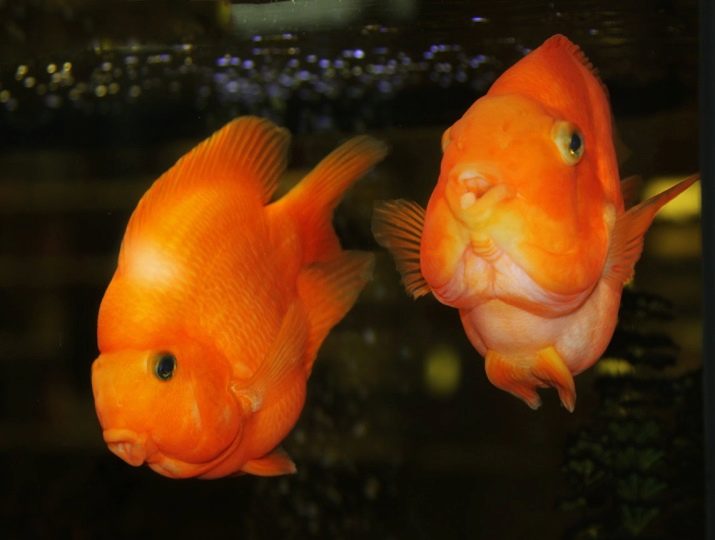
The only breeding option is the crossing of a female parrot with a male of one of the alleged parental forms: these are such fish as severum, labiatum, citrinellum. In this case, full-fledged fry may be born, but outwardly they will look little like parrots. In addition, when selecting parents, the owner will have to separate a couple or even two, and such an alliance does not always bring results.
In this way, breeding at home parrot fish is almost impossible. Individuals from Asian suppliers are brought to Russian pet stores and the secrets of their breeding have not yet been disclosed.
About the features of breeding parrot fish, see below.










